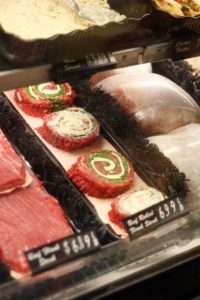We have been discussing food dehydration and recently about drying meat. To understand some of the principles of meat processing and dehydration, we must first understand meat and how additives like salt and other curing agents affect the meat. There must be a relationship between meat chemistry and removal of moisture for drying meats, right? But how well do we know these things really?
Below are 9 questions about meat. Choose the best answer and check it against the correct one we have right after each question. Let’s see how well you understand meat processing.
Table of Contents
The Quiz
1. What are the three components of muscle or meat?
a. carbohydrates, water, and protein
b. carbohydrates, minerals, and vitamins
c. protein, fat, and minerals
d. water, protein, and fat
Answer: D. Meat is basically muscle. It is composed of water, protein, and fat. Although it has carbohydrates, minerals, and vitamins, these are considered lesser components of meat.
2. Which state of water in meat is readily available for microbial growth?
a. bound water
b. restricted or immobilized water
c. free or bulk water
Answer: C. Water exists in meat as bound (restricted or immobilized) water, and free or bulk water. Restricted or immobilized water binds with protein when salt is added. This “binding” makes the meat retain or increases its water content. Another type of bound water is structurally associated with meat proteins, membranes, and connective tissues which can only be removed by very high heat. Bound water is not available for microbial activities.
Free or bulk water, on the other hand, is held only by weak forces such as capillary action. Take for example ground beef. It has more free water than steak because of its greater surface area. This water activity shows the amount of free water in the meat which is conducive to microbial growth.
3. In drying, we want to _____ the water holding capacity of meat.
a. increase
b. decrease
c. maintain
Answer: B. In food dehydration, loss of water and moisture is our main objective. Therefore, we need to lower the water holding capacity of meat.
4. The oxidation state of iron, the protein structure, and the total amount of myoglobin in the meat determine ______.
a. meat color
b. water-holding capacity
c. tenderness
d. solubility
Answer: A. Meat color is dependent on myoglobin protein, which is part of the plasma proteins. Within the myoglobin, protein structure is a heme structure that normally contains iron. The oxidation state of iron, the protein structure, and the total amount of myoglobin in the meat determine its color.
5. Cured meat appears ____ color. As cured meat is heated, the protein denatures resulting in ____ color.
a. brown, red
b. red, brown
c. red, pink
d. purple, red
Answer: C. In the presence of oxygen, fresh meat appears bright red. Without oxygen, meat appears purplish red. Nitric oxide in cured meats replaces the oxygen molecule in the heme (iron) structure thus giving a deep red color. Once cured meat is heated, the protein becomes denatured resulting in a bright pink color.

6. Oxidation from unsaturated fatty acids can be initiated by ____?
a. heat
b. light
c. oxygen
d. all of the above
Answer: D. Chemical deterioration in dried meats most often refers to lipid or fat oxidation. Oxidation is usually started by the action of a catalyst, which includes heat, light, or oxygen. Many different compounds form during oxidation, imparting an atypical flavor and odor in meat known as rancidity.
7. Low temperature _____ rancidity.
a. slows down
b. increases
c. stops
d. does not change
Answer: A. Oxidation of fat forms different compounds that impart a distinguished flavor and odor known as rancidity. This chemical reaction is slow at low temperatures but doesn’t stop. Meat stored in a freezer will still turn rancid though more slowly than meat stored in a cooler.
8. Rancidity is a safety issue.
a. True
b. False
Answer: B. In food dehydration, it is natural to equate rancidity to food spoilage. Once oil is oxidized and emits that rancid flavor and odor, you’ll know. However, rancidity can be slowed down by using antioxidants. Most meat processing methods involve adding antioxidants to slow down or prevent rancidity from developing. Therefore, rancidity is more of a quality issue than a safety issue in meat processing.
9. Dried meats can be classified as
a. sausage, ham, and bacon
b. dry and semi-dry sausages, dried whole muscle meats, and whole muscle meat snacks
c. dry sausages, semi-dry sausages, and hams
d. sausage, ham, and jerky
Answer: B. Dried meats are classified into three. (1) Dry and semi-dry sausages are probably the largest group and include pepperoni, salami, bologna, etc. (2) Dry-cured whole muscle products include prosciutto, pancetta, country hams, etc. (3) Whole muscle meat snacks are mostly jerky products but also include other variations like bites, nuggets, etc.
Final Thoughts
How many correct answers did you have? Don’t worry. This quiz is just for educational fun.
RELATED ARTICLE: A Beginner’s Guide on How to Make Jerky

